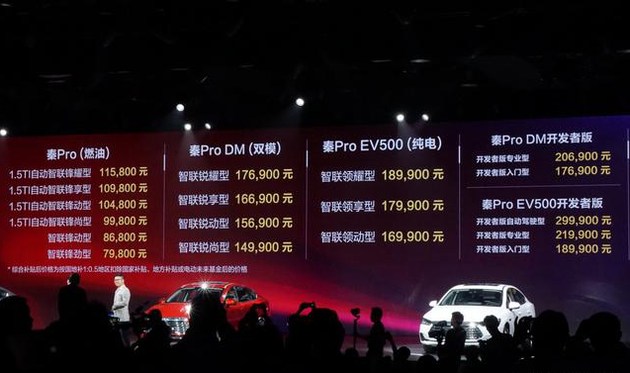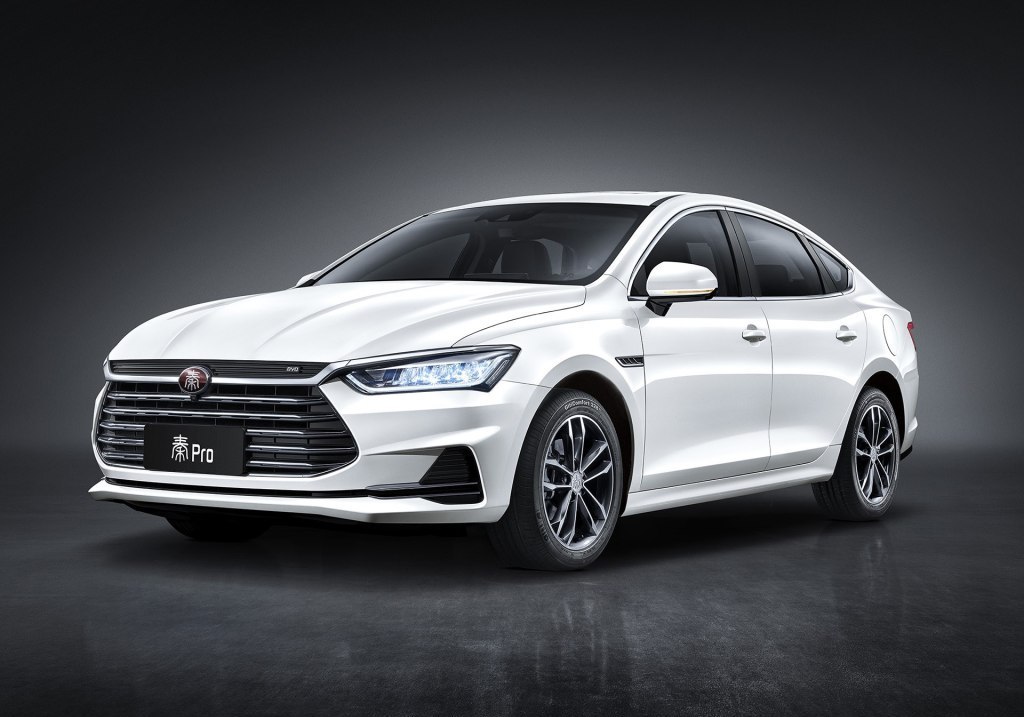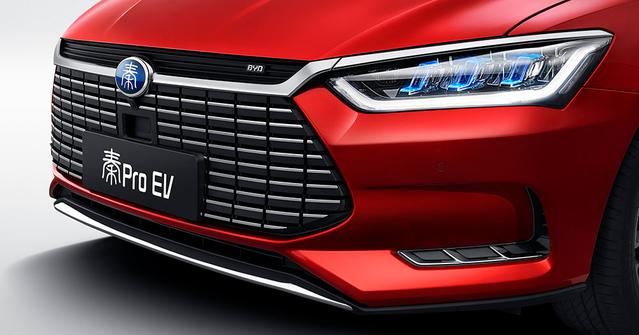Text | Xu Zhe
With the launch of the new Qin Pro today (September 21st), BYD’s Dragon Face family has further grown. As BYD’s fist product this year, Qin Pro, like the new generation of Tang, launched three power versions-fuel version, DM plug-in hybrid version and EV pure electric version.
In terms of selling price, the guiding price of fuel version is 79,800-115,800 yuan, the subsidized hybrid version is 149,900-176,900 yuan, and the subsidized pure electric vehicle is 169,900-189,900 yuan. In addition, models for developers were also released, including 176,900-206,900 yuan for the developer version of Qin Pro DM and 189,900-299,900 yuan for the developer version of Qin Pro EV500.

Continue the "dragon face" design
Before the design director Wolfgang Eiger joined us, BYD’s face value was really heart-rending. Now, the former Audi design director used his "Dragon Face" to end the rustic old face value and the world’s spit for BYD. The reason why he chose "Dragon" as the theme of the design language is precisely because in the vast historical process of thousands of years, the dragon is the totem of the Chinese nation and the symbol of China culture.
Inspired by this, the models of BYD Dragon Face family all adopt a rounded large-size front grille design, with horizontal chrome trim strips, which looks like a faucet, and Qin Pro is no exception, which makes it highly recognizable.
Combined with the long and narrow headlights on both sides, two-color rim design, through taillights, etc., the whole car is more sporty.
The side waistline extends from the front fender to the tail, and the C-pillar is designed in an upward way. Slip-back modeling starts from B-pillar and presses down the curve to the rear of the car. In addition, the new car is also equipped with a five-spoke two-color rim design.
In terms of size, the three versions of BYD Qin Pro are consistent except the height of the car body. The length, width and height of Qin Pro are 4765/1837/1500mm, the wheelbase is 2718mm, and the height of the new energy version is 1495 mm.

In the interior part, the three models are basically the same, and the 8-inch LCD instrument panel and the 12.8-inch rotating large screen are undoubtedly the most eye-catching.
Qin Pro’s central control big screen has an 8-core processor, which can rotate adaptively, and is equipped with Android system, which can realize many interconnected functions such as chatting, games, entertainment, shopping and so on. BYD DiLink’s intelligent networking function also supports the interconnection of mobile phones and vehicles for remote operation.
In addition, the three versions all adopt the popular electronic lever design, but adopt different lever shapes.
Sandian technology highlights are full. DM version may become the main sales force
Qin Pro fuel version is equipped with 1.5L naturally aspirated and 1.5T turbocharged engines, with maximum power of 109 HP and 154 HP respectively, which are matched with 5-speed manual and 6-speed dual clutch gearboxes respectively. The DM plug-in hybrid version is equipped with a hybrid system consisting of 1.5T and a driving motor. The maximum output power of the engine is 154 HP and the peak torque is 240 Nm, while the maximum output power of the motor is 150 HP and the peak torque is 250 Nm. The integrated maximum power of the whole hybrid system is 295 HP, the integrated peak torque is 417 Nm, and the acceleration of 100 km takes only 5.9 seconds.
According to the official introduction, since Qin Pro9 opened the pre-sale on September 5, in less than a month, nearly 5,000 DM plug-in hybrid models have been sold. Not surprisingly, the DM plug-in hybrid model should be the main sales force in the early stage of Qin Pro’s listing.

At the same time, Qin Pro’s high-density and large-capacity battery has an energy density of 160.9Wh/kg and a capacity of 56.4kWh. In terms of cruising range, Qin Pro EV can achieve a maximum of 500km. According to the current national subsidy standard for electric vehicles, Qin Pro EV can get 66,000 national subsidies, and the maximum subsidy amount is 90,000 after local subsidies, which is highly competitive in price.
However, the listing price of Qin Pro is still "high" by netizens.
In particular, there is a certain gap between the starting price of 79,800 and the previous estimate of 60,000. Some netizens bluntly said: "The 1.5T engine is on S7, while the 1.5L engine is on Speedsharp. It costs 30,000 more to change the car shell and configuration, and the Speedsharp is only 50,000, and it has become 79,800 here."
Others compared the fuel version of Qin Pro with Geely Emgrand GL, and thought that the configuration of Emgrand GL was better than Qin Pro at the same price.
Some netizens believe that BYD has expanded after the hot sales of MAX in the Song Dynasty and the second generation in the Tang Dynasty. "I originally took a fancy to this car, but because the Great Wall that I opened now has a huge fuel consumption for five years, the BYD fo I bought for my wife has eight oils, which has made me lose confidence in the engine technology of domestic cars, and I can’t rely entirely on patriotism when buying things."
Affected by subsidies, the profit dropped by 70%.
Looking at BYD’s performance this year, apart from the "Li Juan incident" that has not yet escaped, we have to mention the embarrassment of the sharp drop in profits.
According to the sales report issued by BYD, in the first half of the year, BYD sold a total of 220,000 vehicles, a year-on-year increase of 21%. Among them, the cumulative sales of new energy vehicles reached 71,200, up 106% year-on-year, ranking first in the sales list of new energy passenger cars.
Although BYD’s performance in the first half of the year is good from the sales data, there is still a big gap with its annual target. In January 2018, Zhao Changjiang, general manager of BYD’s automobile sales, once said that BYD hopes to achieve the annual sales target of 600,000 units in 2018, including the target of 200,000 new energy vehicles. As a result, in the first half of 2018, BYD only completed 36.92% of the annual task target, and the new energy part only completed 35.6%.
In addition, according to public data, BYD’s operating income from 2015 to 2017 was about 80.009 billion yuan, 103.47 billion yuan and 105.915 billion yuan respectively; The net profit attributable to shareholders of listed companies after deducting non-recurring gains and losses is about 1.207 billion yuan, 4.613 billion yuan and 2.987 billion yuan respectively; The government subsidies included in the current profit and loss are about 581 million yuan, 711 million yuan and 1.276 billion yuan respectively.
After entering 2018, BYD’s profits have dropped sharply. According to the previous report of Observer Network, it can be found from BYD’s financial report for the first quarter of 2018 that its net profit in the first quarter plummeted by 83.09%. To make matters worse, the semi-annual performance expectation outlook: BYD expects the interim net profit to drop by at least 71%.
In this regard, BYD gave a big profit dive to the "decline in government subsidies for new energy vehicles". The financial report explained that "the overall profit of the new energy vehicle business, including electric buses and new energy passenger cars, has dropped significantly compared with the same period last year."
Of course, the reason for BYD’s profit decline is obviously not only the subsidy decline, but also the unbalanced structure of BYD’s existing models and weak profitability. Therefore, the listing of BYD Qin Pro is particularly urgent.
Back to the product, compared with the self-owned brand cars of the same class in the first echelon on the market today, from the fuel version, Geely Emgrand GL, brand-new Changan Yidong and SAIC Roewe i6 are all competing products of Qin Pro. In terms of new energy, two new energy compact cars, Roewe ei6 and MG 6, owned by SAIC will compete with Qin Pro.
This article is an exclusive manuscript of Observer. It cannot be reproduced without authorization.
关于作者